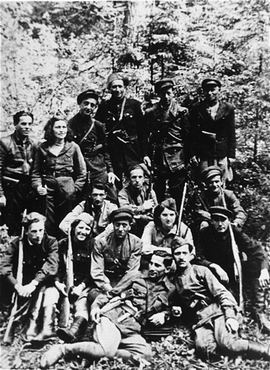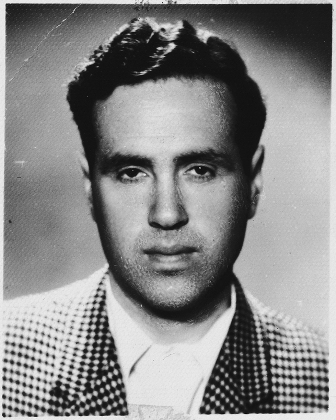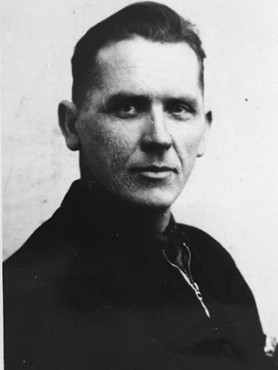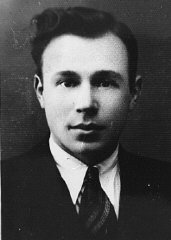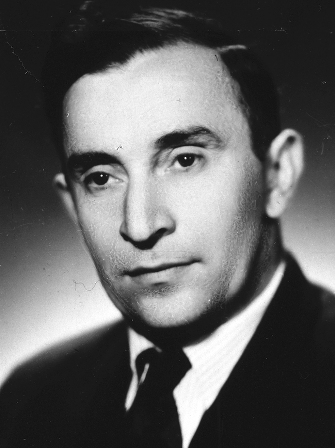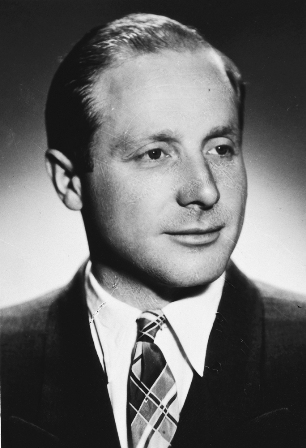Holocaust Education & Archive Research Team |
Revolt & Resistance
Acts of Resistance
Jewish Resistance
Groups Jewish Resistors Allied Reports Anti-Nazi Resistance Nazi collaborators
| ||||||
The Gelpernus Diary Resistance in the Kovno Ghetto Chaim Yelin & Dimitri-Ghelpernus
Part II "Underground Struggle"
I. THE FORMATION OF THE MILITARY ORGANIZATION
The main aim of the struggle for the antifascist and partisan organization in Kovno ghetto was formulated so: "Organizing resistance forces, mobilization of able people and a search for the ways to join general partisan movement".
With time the organization began to develop in two main directions: setting up groups with the aim of taking them to partisan bases and organizing resistance on the spot while using all possibilities and attracting broad masses of the ghetto residents into the struggle.
At the head of the antifascist organization was a committee of five (later seven) people. Every committee member was responsible for a particular area. There were six main operational areas:
Until the end of October 1943 the committee consisted of the following members (with only slight alterations) : Haim Yelin - secretary with responsibilities for cadre and special issues, Peisach Gordon Shtein and Moishe Sherman - military actions, Dmitry Gal'perin - agitation and communications; Mary Lan was responsible for organizational issues; Alta Boruchovich-Teper was responsible for social issues. Moishe Rubinson was made responsible for activities of the komsomol group.
Comrades able to fight belonged to the military part of the movement. In order to preserve strict secrecy there were only three or four people in each primary cell with a secretary who was responsible for ensuring contact with the leadership. Seven cells made up a section with a section leader. Apart from a military section there was an auxiliary one which was responsible for material resources of the movement; mainly, it had to search out the ways of arms and weapons acquisition. People unable to fight joined this sector. Five to eight people made up an auxiliary sector cell with a secretary who ensured contact with section leadership.
It was arranged for cell meetings in each sector to take place every week (depending, of course, on the situation in the ghetto). Each Tuesday the committee planned actions for the week. On Fridays leaders of the military and auxiliary sections were briefed, on Saturdays cell secretaries met, while meetings of the cells themselves took place on Sundays.
It was not easy to meet in small ghetto flats without being noticed by outsiders. Weekends were the "quietest" periods for ghetto inhabitants - not often people were taken away for forced labour. This time was used for meetings in the cells. At the beginning of the week the committee received a report from section leaders and cell secretaries about the carried out work. Conclusions were drawn.
Agendas for cell meetings were usually the following: 1) report on political and front situations; 2) discussion of week's events; 3) military and other briefings; the latter ones were also part of special meetings; 4) sabotage - a) reports of individual fighters on their actions; b) briefing on future actions and discussion of typical incidents; c) discussion and approval of action plans for each individual comrade; d) setting the issues concerning acquiring funds for the movement; 6) current issues.
Weekly cell meetings were an important part of their members lives. Cell members could rise above ghetto daily life on those occasions. The movement organizers wanted to call it "Activists' Union". But it failed to be accepted in everyday language. People became accustomed to using the word "organization". Both anti-fascist and partisan movements became known by this word.
II. SABOTAGE
Every member of the anti-fascist organization in Kovno ghetto signed such oath with his/her pseudonym. People who took this oath solemnly observed it.
The slogan of the organization - " to harm the enemy with all available means and everywhere" - became a precept for every member.
One February evening in 1942 Kovno sky lit up in a red flame. The fire was clearly seen on the other side of the frozen river Neris, in the streets of the ghetto. It was obvious that three largest city saw-mills situated on the river banks were on fire.
"Saw-mill workshops and storehouses with completed products, for Wehrmacht detachments suffering from cold, are on fire,"-the word spread through the ghetto.
Though few of the Jews knew that some members of the ghetto underground movement were "to blame" for the fire starting. While active member Leib Segalov was directly involved in this act of sabotage. "Leibka did not let us down. He has started paying back for the death of his wife and child!"- Haim Yelin wrote in his notes on that occasion.
April 1942. An empty German hospital carriage stood on the fourth line of Kovno railway station. Some Jews were unloading coal nearby. It was 3 a.m. Soviet bombers suddenly attacked. Germans left the scene for the bomb shelter in panic. Only Yankl Kopelman, a young lad, did not try to hide. Using the absence of the Germans he got into the hospital carriage and having noticed a burning iron stove, he turned it upside down. Hot coal fell onto the floor.
Few minutes later the whole carriage was on fire. The Germans were still in the shelter. Before they managed to leave it and started putting the fire out three carriages burned down.
Fifth Fort in Kovno suburb Panemune was used as an army depot. Jews were brought here to carry out a heavy and dangerous job of loading and unloading, but members of the underground organization volunteered to go there. Firstly, it presented an opportunity to hide grenades and ammunition as soon as the guard turned his head away. These could later be transported to the ghetto. Secondly, they often could remove fuses from grenades and bomb capsules and make these things unusable.
Once they managed to do something even more significant: when they had loaded assignment of grenades boxes of fuses finished up on a boat going in a different direction. Though the most significant act of sabotage took place in July 1943. Meer Lurie, Faivel Parad payed with their lives and Rachmiel Sheiniuk lost his left hand but a large amount bombs, artillery ammunition, hand grenades went up in smoke. Two Germans were blown to pieces. Many windows in parts of Kovno were caused to crack by the explosion.
Moishe Slaviansky in a group of Jews was sent to do forced labour. They had to unload several carriages of timber. German guards hurried them up with their rifles, "Schnell! Schnell! (Quick!)"
This order could not apply to Slaviansky- he was unloading his carriage quickly. Germans were even surprised at such a strong man being from an "inferior race". Slaviansky arranged beams so cleverly near the rails that Germans failed to notice that some of the big beams finished under the carriages. When the locomotive began moving several carriages were de-railed and turned upside down.
Sabotage increased with every day. Every member of the organization had not only to carry out acts of sabotage but also to involve other people. After performing his task whether on his leader's orders or at his risk when the opportunity arouse every member of the organization had to report. Those reports were kept by responsible members who systematically informed the leadership - committee - about the completed acts of sabotage. Every useful innovation used to become a norm for all. Leaders' reports about the acts of sabotage were kept for a long time by Haim-Dovid Ratner. We give now some examples from Ratner's notes found in one of his remaining exercise books.
"III. (Roman numbers refer to months). Comrade Pock (Moishe Zemelevich) added some snow when filling up sacks with grain. A large amount of grain perished." "
IV. 'General-commissar' receives 200 litres of petrol weekly. Similar amount of petrol was poured out by our comrades working in m/h (military hospital)."
"V. Medicine is of special importance in war times. When unloading a box with hundreds of ampoules from a truck, comrade S. (Motl Stern) picked up his side of the box in a manner which caused the Lithuanian driver to drop it. Ampules broke." It is neither first nor the last time"- happily commented the driver- "perhaps, I will also be able to near its end... Comrade S. found a reliable ally in his sabotage work."
"VI. When working on a consignment of gas masks intended for the front, our comrades removed six hundred filters."
"VII. Working in a garage comrade M. (Moishe Milner) filled accumulators with 80% of acid and 20% of distilled water the opposite of the required proportions. The damaging effect is doubled: firstly, loss of valuable acid, secondly, acid destroys accumulators. 98 accumulators have been destroyed."
"VIII. Cobler A. (Haim Aron) and his team in g.w. (ghetto workshops), prepared a large number of boots with very thin soles and then cut diamond shapes on them. A short while later a thousand pair of boots were returned for repairs."
Ghetto resistance organization widely used experience of other organizations when performing acts of sabotage. It was reported on the radio that German transport suffered badly because of mix-ups in labelling and documentation. People trained for performing special tasks were sent to railway depots and workshops for forced labour.
They caused havoc in the work of the railway. Carriages were delayed or sent in the opposite direction. On the members' initiative parts of locomotives were removed and hidden, railway points switched without orders. At the beginning of 1942 a train full of goods passed at full speed near factory "Maistas", collided with a stationary group of carriages and completely destroyed them. Resistance fighter Lucia Zimmerman initiated this act.
Leib Gempl, Itzik Weiner and others working in the depot systematically removed and changed carriage labels which had information about necessary repairs. This resulted not only in chaos, constant arguments and quarrels in the railway workshops, but also one frequently heard of accidents with carriages which had only recently left the workshops due to remaining faults.
At every possibility electrical telephone, telegraph wires were cut. In June 1942 Leib Moshkovich cut the wiring of Kovno airdrome sirens - during an attack by Soviet bomber fighters those sirens were silent.
III. PREPARATION FOR STRUGGLE
The leadership of the organization was well aware of the damage caused by sabotage to enemy's home front. However, they considered joining the main forces in the armed struggle against the invaders to be their main aim. Hence among their primary tasks was acquisition of means of struggle - weapons, and arming of the military sector.
"Weapons can only be obtained by means of weapons!" - stated in an old partisan rule. Yet, this rule was of little help in ghetto conditions. One had to get weapons with bare hands. The organization sent its members to such places where such opportunity existed. David Teper was the first to get hold of rifle parts stolen from a German field command post. In the ghetto they put those parts together, added on a butt - and the first rifle was ready for young fighters to learn shooting.
Zalel Iofe, Mendelson and others had made it a rule not to return to the ghetto without some spares for rifles or hand guns which they stole from armoury workshops where they were sent to do forced labour. Metal worker Shmushkevich brought from the same workshop parts which he used to assemble two machine-guns. Real armoury workshops sprung up in the ghetto.
Alter Faitlson and Israel Miltstein manufactured knives and special axes. Saul Pinkes, Haim-Dovid Ratner, Alter Rashkovich manufactured rifles and missing parts. Joiner Efroim Rutnberg supplied all rifles with good butts. At the risk of losing life they even managed to smuggle complete rifles into the ghetto.
Shmuel Baron tucked a stolen rifle into the belt -with its butt up and barrel inside his trousers. Admittedly it was very uncomfortable to walk a long distance to the ghetto, also the Germans observed the workers very carefully. In spite of that Baron managed to smuggle several rifles into the ghetto. Iosl Michles managed to get through ghetto fence with two rifles at once. If you had to risk your life you might as well do it with maximum gain! Michles was followed by others.
Young Sulamif Lerman went to the town disguised as a besom seller. In those besoms arms were hidden. Meer Neistadt organized a delivery of rifles to the ghetto in the transport which usually delivered building materials to ghetto workshops.
Iankl Levi became soon famous for his trips to the town to obtain weapons for the organization. Short and slightly stooping he looked like a Lithuanian peasant with a walking stick in his hand, a pipe in his mouth and long moustache pointing upwards. No German guards would dream of checking his documents. But just in case the underground fighter was given a false passport in the name of Antanas Gudauskas. Iankl carried out the most dangerous tasks and delivered many weapons to the ghetto with characteristic composure, caution and at the same time energy.
Sonia Rubinson, Liuba Schwartz, Ghita Abramson obtained weapons at their place of work in a German hospital.They used various cunning ways. Once the girls hid two stolen rifles under a bed mattress in an empty ward. In the evening Ida Pilovnik came to the adjoining yard and took the rifles to the ghetto. The same girls smuggled revolvers and ammunition in a sauce-pan with a concealed bottom. In those pans they used to leave a bit of soup as if it was their supper.
With the same aim Lowa "Lieb" Sher made holes in logs which he took to the ghetto as if for a stove. Some obtained weapons at work after stealing them from the Germans. In most cases Germans did not even suspect Jews of theft. But after suspicions had arisen those comrades had to live illegally.
Not every time they managed to get through inspection at the ghetto entrance successfully. A German inspector found parts for a rocket pistol hidden among firewood carried by Rachmiil Berman and handed him over to Gestapo.
Enach Segalovich obtained a considerable amount of weapons for the organization. This experienced underground fighter braved the streets without any yellow patches. Though Segalovich did not have typical Jewish appearance, during one of his trips to the town to pick up arms he was recognized as a Jew by police and after torture he was shot dead in the 9th Fort.
In order to obtain more weapons the organization was forced to buy some. This needed a good network of contacts who had to breach the ghetto fence in both directions many times till they managed to obtain either a revolver, a rifle or some ammunition.
Committee members did not simply direct the whole process of finding, buying, delivering and safe-keeping those weapons but also actively participated in the work. Haim Yelin and Alta Boruchovich-Teper obtained and brought into the ghetto many rifles, hand guns, hand grenades and bullets.
Piotr Trofimov, Maria Leshchinskiene, Eliana Kutorghiene, Aleksas Puros and others helped to get weapons in the town. Juozas Vitkauskas got also considerable amount of weapons for the organization. Iosl Michles regularly received those weapons from Vitkauskas. Gestapo tracked down Vitkauskas and shot him with his wife and child.
Many ghetto residents tried to obtain weapons but outside a well- organized group it lead frequently to a failure. Benzion Harles and Sholom Melsak died while trying to get weapons. In November 1942 a guard stopped watch-maker Nokhem Mek when the latter was attempting to smuggle a pistol through the fence. Mek was publicly hanged in the ghetto, his family was also executed. Another 20 residents lost their lives in reprisals.
Military and technical sector began training its members as well obtaining weapons. This is what the "military programme" of the organization has to say about it:
"Military training includes lectures and practical classes on the following topics: military discipline, camp planning, forest life, building a dug-out, methods of fighting (attack and defence), mechanisms of rifles, pistols, hand grenades, machine guns, shooting from different types of weapons (machine guns, tanks, cannons), arson, contacts, Morse code, scouting, topography (signs and instruments) and a course on medical treatment in battle conditions.
Systematic training took place in safe houses at 4 Broliu street, 36 Ariogalos street, 27 Puogiu, 8 Linkmianu street, 95 Krikshtshiukaichio street (* now Shimaite street). Fighters learned to use maps, and how to treat the injured. A lot of effort was put into learning Red guard's manual. Shooting was learned in well insulated and hidden basements of 7 Mildos and 3 Nashlaichiu streets.
The military-technical sector directed setting up of shelters for hiding weapons and also those comrades who had to leave in hiding, for secret meetings and conspirator purposes. The following extract was taken from article No.3 of the "military programme":
"The question of shelters was an important issue from the first days of the organization for a number of comrades had to leave in hiding for political reasons. With further development of our work documents, material and means of struggle appeared which needed to be hidden. Military training includes both fighters' training and preparation of means of struggle which enable this struggle. These means must be kept in special secret places.
All members of the organization (or a cell as a minimum) must find such a place for materials and other illegal objects. Shelters for people, materials, objects are owned collectively and should be built according to a common plan. Shelters for people are meant for : 1) comrades who have to hide for various reasons; 2) hiding during German round-ups; 3) for secret meetings; 4) hiding during bombing.
For this to happen we need the following building materials : beams, planks, nails, cement, bricks and necessary instruments; it is important to ensure that each shelter has water containers, torches, candles, matches, shovels, crow-bars, axes, hammers, wire cutters, dry food (dry bread), certain amount of "hot macaroni" and "cold klotskas (dumplings)" - according to the size of the shelter and the number of people.
"Hot macaroni" and "cold klotskas" were secret names for fire arms and steel weapons.
Continued...
[Part 1] [Part 3] [Part 4] [Part 5] [Part 6] [Part 7] [Part 8]
Sources: Chaim Bargman: translator Yiddish-Russian (L) with Robin O’Neil: translator Russian – English. Kaunas, Lithuania 2007 (photos: GFH, USHMM, & Private Collections)
Copyright H.E.A.R.T 2008 [Page design by Carmelo Lisciotto]
|
